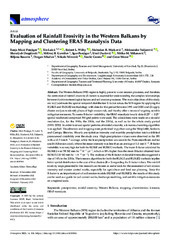Приказ основних података о документу
Evaluation of Rainfall Erosivity in the Western Balkans by Mapping and Clustering ERA5 Reanalysis Data
| dc.creator | Micić Ponjiger, Tanja | |
| dc.creator | Lukić, Tin | |
| dc.creator | Wilby, Robert | |
| dc.creator | Marković, Slobodan | |
| dc.creator | Valjarević, Aleksandar | |
| dc.creator | Dragićević, Slavoljub | |
| dc.creator | Gavrilov, Milivoj | |
| dc.creator | Ponjiger, Igor | |
| dc.creator | Durlević, Uroš | |
| dc.creator | Milanović, Miško | |
| dc.creator | Basarin, Biljana | |
| dc.creator | Mlađan, Dragan | |
| dc.creator | Mitrović, Nikola | |
| dc.creator | Grama, Vasile | |
| dc.creator | Morar, Cezar | |
| dc.date.accessioned | 2023-06-09T12:43:08Z | |
| dc.date.available | 2023-06-09T12:43:08Z | |
| dc.date.issued | 2023 | |
| dc.identifier.issn | 2073-4433 | |
| dc.identifier.uri | http://gery.gef.bg.ac.rs/handle/123456789/1315 | |
| dc.description.abstract | The Western Balkans (WB) region is highly prone to water erosion processes, and therefore, the estimation of rainfall erosivity (R-factor) is essential for understanding the complex relationships between hydro-meteorological factors and soil erosion processes. The main objectives of this study are to (1) estimate the spatial-temporal distribution R-factor across the WB region by applying the RUSLE and RUSLE2 methodology with data for the period between 1991 and 2020 and (2) apply cluster analysis to identify places of high erosion risk, and thereby offer a means of targeting suitable mitigation measures. To assess R-factor variability, the ERA5 reanalysis hourly data (0.25° × 0.25° spatial resolution) comprised 390 grid points were used. The calculations were made on a decadal resolution (i.e., for the 1990s, the 2000s, and the 2010s), as well as for the whole study period (1991–2020). In order to reveal spatial patterns of rainfall erosivity, a k-means clustering algorithm was applied. Visualization and mapping were performed in python using the Matplotlib, Seaborn, and Cartopy libraries. Hourly precipitation intensity and monthly precipitation totals exhibited pronounced variability over the study area. High precipitation values were observed in the SW with a >0.3 mm h−1 average, while the least precipitation was seen in the Pannonian Basin and far south (Albanian coast), where the mean intensity was less than an average of 0.1 mm h−1. R-factor variability was very high for both the RUSLE and RUSLE2 methods. The mean R-factor calculated by RUSLE2 was 790 MJ mm ha−1·h−1·yr−1, which is 58% higher than the mean R-factor obtained from RUSLE (330 MJ mm ha−1·h−1·yr−1). The analysis of the R-factor at decadal timescales suggested a rise of 14% in the 2010s. The k-means algorithm for both the RUSLE and RUSLE2 methods implies better spatial distribution in the case of five clusters (K = 5) regarding the R-factor values. The rainfall erosivity maps presented in this research can be seen as useful tools for the assessment of soil erosion intensity and erosion control works, especially for agriculture and land use planning. Since the R-factor is an important part of soil erosion models (RUSLE and RUSLE2), the results of this study can be used as a guide for soil control works, landscape modeling, and suitable mitigation measures on a regional scale. | sr |
| dc.language.iso | en | sr |
| dc.publisher | Basel : MDPI | sr |
| dc.relation | info:eu-repo/grantAgreement/EC/H2020/952384/EU// | sr |
| dc.rights | openAccess | sr |
| dc.rights.uri | https://creativecommons.org/licenses/by/4.0/ | |
| dc.source | Atmosphere | sr |
| dc.subject | precipitation | sr |
| dc.subject | rainfall erosivity | sr |
| dc.subject | Western Balkans | sr |
| dc.subject | mapping | sr |
| dc.subject | clusterization | sr |
| dc.subject | k-means | sr |
| dc.subject | ERA5 reanalysis | sr |
| dc.title | Evaluation of Rainfall Erosivity in the Western Balkans by Mapping and Clustering ERA5 Reanalysis Data | sr |
| dc.type | article | sr |
| dc.rights.license | BY | sr |
| dc.citation.volume | 14 | |
| dc.citation.issue | 1 | |
| dc.citation.spage | 104 | |
| dc.citation.rank | M23 | |
| dc.identifier.doi | 10.3390/atmos14010104 | |
| dc.identifier.fulltext | http://gery.gef.bg.ac.rs/bitstream/id/2996/bitstream_2996.pdf | |
| dc.type.version | publishedVersion | sr |


